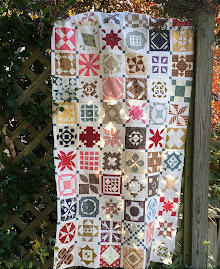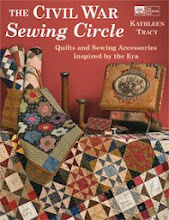How many of you hand quilt some (or all) of your small quilts? For awhile it seemed to be somewhat of a dying art. But now I'm hearing that there's been a surge in popularity and quilters are being drawn to hand piecing and slow stitching. And I'm always happy to see quilters pick up a needle and thimble and try it. Hand quilting a small quilt is a great way to get started. While hand quilting a large quilt can take a really long time, quilting a small quilt can be done quickly and is just as rewarding. I hear people say they don't have the patience for it but I've found that the patience needed actually comes from the focus and attention paid while you're doing it. Enter the small quilt with simple stitches.

Simple stitches are perfect for hand quilting small quilts. Sometimes you don't need to do much quilting at all to give a primitive, childlike look to a piece. And they don't necessarily need to be perfect. Take a look at antique quilts and see that the stitches are almost never perfect. Some are, but I love the ones that are not quite exact so you get a sense of the human effort that was involved. The average quilter from long ago was not always making her quilts to purposely enter them in quilt shows.
Hand quilting doesn't have to be fancy and there are no rules that say you have to be an expert and your stitches have to be perfect before you do it. I do it for fun and relaxation and because I love the look.
I've been asked about the thread and needles I use for hand quilting. I have to stress that everyone is different. And so what works for me may not be right for you. You have to try a few things to see what works best. But here's some things that might help -
* I like YLI hand quilting thread in light brown. Sometimes hard to find. Try eBay, Etsy or Red Rock Threads. Or the YLI company. Cotton thread is best. Look for one that's coated with a glaze that allows the thread to withstand the stress of being pulled stitch after stitch without shredding.

* There is no CORRECT needle to use for hand quilting. Because everyone is different, what is comfortable for me to use may not be right for you. The needle you use can make a huge difference. It should be one you can handle and thread easily or your quilting adventures will be disappointing and frustrating. You will need to select the needle you feel most comfortable using and should try several to see which one fits YOU. Don't give up on quilting until you try several different needle sizes and brands. I often use a different needle depending on the fabric used in the project I am quilting or how my hands are feeling that day.

* Some quilters prefer short needles, some prefer long, thin needles. Small Between needles are always difficult for me. But that's what you hear most quilters say they use. I've been happy with this size 9 by Richard Hemming lately. Not too short. Or John James Gold 'n Glide needles. Or I'll use a longer sharp needle on other days if my hands are feeling kind of stiff or the backing fabric I'm using is starched or stiffer than usual. Clover Milliners' Gold Eye are good. Bohin is a trusted brand. So is Tulip. There are lots of different needles out there to try. check your local quilt shop if you get confused. Packages of needles are pretty cheap so get a few and try them out. Some come in packages of assorted sizes. You may have to practice to see what you're comfortable using.
My quilting improved when I began to use a longer, thinner needle instead of the tiny needle other quilters told me I should be using. I found I could also load more stitches on the needle and my hand did not tire as rapidly. Know what? The Quilt Police won't even know what needle you're using. My advice: pick a needle that is easiest for you to use. The right needle for you is the one that will allow you to quilt without frustration or pain. Do what makes quilting enjoyable for you.
* Some fabrics are more difficult to quilt through so you may want to try a sharper needle if you have trouble. Starched blocks make hand quilting more difficult too. I try to make sure my backing fabric is soft and not too stiff. Makes it easier on my hands. John James Gold 'n Glide needles work great for me. This is a big reason I do not starch my blocks. Yes, you may get a crisper look to your piecing but it's harder to quilt through.
* Cotton batting always works best for me. Quilters Dream Cotton "Request" is my favorite right now for an antique look in small quilts. Polyester batting is easier to quilt through but gives a "puffy" look. Flannel seems too flat for me but it's another popular option quilters recommend. If you buy the Quilters Dream cotton, careful - Quilters Dream Cotton "Select" is a little thicker so better for larger quilts.
* I mark my quilting lines with a washable marker. Then just stitch on the lines.
I like the Clover brand. Blue ink pens for marking light fabrics and white ink for dark fabrics. You can see the blue lines drawn in the triangles that I then stitched along. The ink from these Clover pens comes out with a cold, damp cloth rubbed across the lines. I've found that cold water is best as warm or hot water might heat set the lines and make the ink a little more difficult to remove. Always test on a scrap first and follow instructions on the product you're using. Do NOT press with a hot iron.
There's also a product called Tiger Tape that comes on a roll. You set it on the places you wish to quilt instead of marking a line. Then stitch along the tape which has lines and markings to follow to help your stitches come out straight and evenly spaced. Even now I will sometimes place masking tape across a block and follow along the edge with my stiches so I get a straight line.
I really enjoyed hand quilting parts of my Schoolgirl Sampler. Simple stitches worked well for this one. Take it one block at time . . . .
If you've tried and given up, Remember, it may not be YOU - it could be the needle, fabric or batting you're using.
I would love to say I hand quilt all of my quilts but, like many of you, who has the time?? So I do my best and enjoy putting in some simple stitches on my small quilts. Nothing fancy, just enough to give the quilt a little bit of dimension. Hand quilting should be a pleasant, relaxing venture. And it may take awhile to find your rhythm so try different tools to see what makes it most comfortable. Practice! Here's an idea - When I first started quilting I practiced on pre-printed fabric panels. I layered them with batting and backing and just followed the lines on the design. That way I didn't feel like I was ruining a nice quilt I'd pieced if I made a mistake or my stitches were a little wonky.
I'm far from being an expert on hand quilting, but think about some of my suggestions or ask around at your local shop or guild. Look up some hand quilting videos on YouTube. And then, go ahead, mark your quilt and get started! Hand quilting is fun. It's well worth the effort. But you won't really know until you try.
-Kathy












.JPG)














12 comments:
Thank you for taking the time to explain your methods, tips, tricks, supplies, etc. I sincerely appreciate it.
What kind of thimbles do u use?
I love all your photos, such lovely farbrics and hand quilted, too! I have almost always hand quilted all my quilts from small ones to queen size. I am just happier with hand quilting, it is so relaxing.
Thank you Kathleen.I am experimenting using all the things you've discussed. I am going to try to "stich in the ditch" on a mini. I have a few of your books and I love all the historical information and beautiful photos!
Donna Tremain
Thank you for this post. Lots of useful information about hand quilting. I hand quilt all my quilts from small wall hangings to queen. Part of the reason is I can't afford to have them long armed but I have always found hand quilting to be so relaxing and rewarding. And thank you for sharing all your beautiful small quilts.
I love this blog post so much! I've been intimidated by the quilt police. I've only quilted one small quilt by hand, and though I like it, it is certainly not perfect. And I cannot use those tiny, short needles. Thank you for giving me liberty and inspiration to try again!
beautiful stitching! I luv to hand quilt but my hand not so much 😄
Every single quilt pictured is absolutely gorgeous! I hope to get to that level of talent someday! I am such a newbie at all of this. I was actually thinking about hand quilting the other day - if I end up with a practive block that turns out perfect - why not? But your suggestion to practice on something first is VERY GOOD advice! Sounds like the perfect thing for me to sit on the couch and practice in the evenings! Thanks for the post!
I'm always so happy to see the hand of the stitcher in a quilt. Just my preference. I'm so over the search for perfection, the computerized stitch, the idea of quick quilts. But that's just me. To each their own. I know it takes a great deal of skill and patience to use a long arm but it's just not me. Lobe your hand stitched quilts!
Years ago I earned extra money by hand quilting. Things are different now, and I haven't hand quilted in over 30 years! But I love the look. The large stitches in hand quilting that are so popular now just turn me off. When I hand quilted, everyone wanted the tiny stitches. To this day I feel the tiny stitches are better, but that's just me.
Thanks so much for this post! This hits all the buttons about “do it your way”. Whatever feels more comfortable for you!
Post a Comment